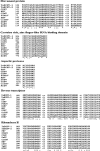Characterization by Small RNA Sequencing of Taro Bacilliform CH Virus (TaBCHV), a Novel Badnavirus
- PMID: 26207896
- PMCID: PMC4514669
- DOI: 10.1371/journal.pone.0134147
Characterization by Small RNA Sequencing of Taro Bacilliform CH Virus (TaBCHV), a Novel Badnavirus
Abstract
RNA silencing is an antiviral immunity that regulates gene expression through the production of small RNAs (sRNAs). In this study, deep sequencing of small RNAs was used to identify viruses infecting two taro plants. Blast searching identified five and nine contigs assembled from small RNAs of samples T1 and T2 matched onto the genome sequences of badnaviruses in the family Caulimoviridae. Complete genome sequences of two isolates of the badnavirus determined by sequence specific amplification comprised of 7,641 nucleotides and shared overall nucleotide similarities of 44.1%‒55.8% with other badnaviruses. Six open reading frames (ORFs) were identified on the plus strand, showed amino acid similarities ranging from 59.8% (ORF3) to 10.2% (ORF6) to the corresponding proteins encoded by other badnaviruses. Phylogenetic analysis also supports that the virus is a new member in the genus Badnavirus. The virus is tentatively named as Taro bacilliform CH virus (TaBCHV), and it is the second badnavirus infecting taro plants, following Taro bacilliform virus (TaBV). In addition, analyzes of viral derived small RNAs (vsRNAs) from TaBCHV showed that almost equivalent number of vsRNAs were generated from both strands and the most abundant vsRNAs were 21 nt, with uracil bias at 5' terminal. Furthermore, TaBCHV vsRNAs were asymmetrically distributed on its entire circular genome at both orientations with the hotspots mainly generated in the ORF5 region.
Conflict of interest statement
Figures






References
-
- Brunt AA, Crabtree K, Gibbs A. Viruses of tropical plants Descriptions and lists from the VIDE database: CAB International; 1990.
-
- Pearson M, Jackson G, Saelea J, Morar S. Evidence for two rhabdoviruses in taro (Colocasia escudenta) in the Pacific region. Australasian Plant Pathology. 1999;28:248–53.
-
- Yang I, Hafner G, Dale J, Harding R. Genomic characterisation of taro bacilliform virus. Archives of Virology. 2003;148:937–49. - PubMed
-
- Revill P, Jackson G, Hafnerc G, Yang I, Maino M, Dowling M, et al. Incidence and distribution of viruses of Taro (Colocasia esculenta) in Pacific Island countries. Australasian Plant Pathology. 2005;34:327–31.
-
- Revill P, Trinh X, Dale J, Harding R. Taro vein chlorosis virus: characterization and variability of a new nucleorhabdovirus. Journal of General Virology. 2005;86:491–9. - PubMed
Publication types
MeSH terms
Substances
Associated data
- Actions
- Actions
LinkOut - more resources
Full Text Sources
Other Literature Sources
Research Materials

